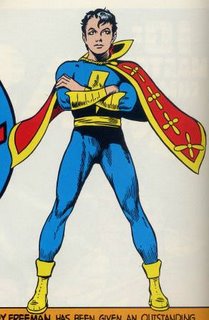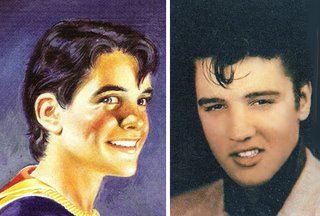
As superhero comics grew in popularity, and more comics started crowding the shelves, publishers needed to find new ways to attract readers, most of whom were kids. One bright man at National (later, DC) comics decided that although Batman was popular, kids couldn’t identify with him- they needed someone their own age in the book. Thus, Robin was born.
And, as they had done after Superman’s debut, rival publishers rushed to copy the formula. Captain America had Bucky, the Human Torch had Toro, Green Arrow had Speedy (which always confused me because I thought someone named “Speedy” would team up with the Flash), and, in a novel twist, the young hero Star Spangled Kid had a grown-up sidekick named Stripesy.
With the exception of Robin, these sidekicks never really achieved the same level of popularity and name recognition of their grown-up counterparts. And with the exception of none of them, they were all inferior versions of their guardians.
Well- there was one exception- Captain Marvel, Jr. And with the first volume of The Shazam Family Archives, DC has finally released a deluxe volume of his adventures. (Technically, the Shazam Family also included Mary Marvel, but her first appearance is the last story in the book, so I guess she’ll have a bigger presence in subsequent volumes). Anyway- back to Cap, Jr.
Freddy Freeman was out fishing with his grandfather one day when the rescued a man who appeared to be drowning. Little did they know this man was the evil Captain Nazi (hey- it was WWII, who else would he encounter?) who was just lost a fight with Captain Marvel. Captain Nazi quickly recovered, drowned the old man, crippled Freddy with a blow from an oar and made off with the boat. Luckily, Captain Marvel was nearby and, hoping to save the boy’s life, he took Freddy to the wizard Shazam. Shazam saved Freddy, and also bestowed upon him superpowers. All Freddy would have to do was say “Captain Marvel” and he would be transformed into Captain Marvel, Jr. (Which also meant that he could never say his own name without turning back into Freddy.)
Junior took up residence in Master Comics #23 (Feb. 1942), and got his own title the following November. At the beginning, he was drawn by Mac Raboy, one of the true greats of the era. He had a great style, with lots of fine linework. His use of photo-references enhanced the realism and grittiness of his art, which was a definite contrast with the much lighter style CC Beck employed on Captain Marvel’s titles.
And the tenor of the stories reflected the difference styles. Teenaged Billy Batson (Cap’s alter ego) worked for WHIZ radio and had a pretty nice house of his own. Crippled Freddy Freeman (Shazam gave him superpowers, but couldn’t fix his leg) was a paperboy who lived in a depressing attic in a rundown neighborhood. Cap’s arch-enemies were Dr. Sivana who tended to be more naughty than evil, and Mr. Mind, an intelligent worm. Junior had to deal with Captain Nazi (who definitely would kill the kid if he had the chance), Mr. Macabre (who apparently was Fawcett’s Joker wannabe), and lots of kidnappers. Freddy always seemed to be in a lot more real danger than Billy was.
What’s great about Junior is that he could hold his own against really scary villains. As I said earlier, you had the feeling that if Captain Nazi ever managed to get the drop on him, Junior was toast. But Junior always made it to the end of the story. I don’t think Batman would have ever let Robin even contemplate going up against the Joker by himself. And Junior’s powers were probably pretty close to Cap’s own levels. He might have been a kid, but he was a serious contender.
The only problem with this volume is that, at this early stage, Junior had a limited rogue’s gallery- there are 15 stories in the book. In these 15 stories, he fights Captain Nazi 5 times, and Mr. Macabre 3 times. Although he does go up against the Japanese air force in one story, he spends most of the rest of the stories fighting street hoods. For example, in “Case of the Cripple Crimes,” Freddy is taken in by Dr. Krool and Prof. Swype, two Fagin-types who teach orphans how to pick pockets. The artwork is very nice, the story dark, but these two criminals are definitely outclassed by Junior.

I like the fact that Freddy’s youth, poverty and physical limitations are used to good effect to get him involved in cases. More than once he is put into situations where he is in real danger. But once he turns into Captain Marvel Junior, he is way too powerful for most of his foes, and the dramatic tension goes away.
Still, to get back to my original point, Cap Junior made a great junior-league hero. While I have a hard time putting up with the Golden Age Robin even when Batman’s with him (and Robin was still more appealing than Bucky Barnes), I am enthralled by Junior’s adventures.
And I’m not the only one who felt that way. Apparently, a young boy from Tupelo, Mississippi was a huge fan, going so far as to style his hair in the same manner. And when he got a little older, and a little richer, he had clothes modeled on Junior’s- right down to the cape and a lightning bolt on his belt buckle.
That boy?*

*Think I'm kidding? Check this out-


No comments:
Post a Comment